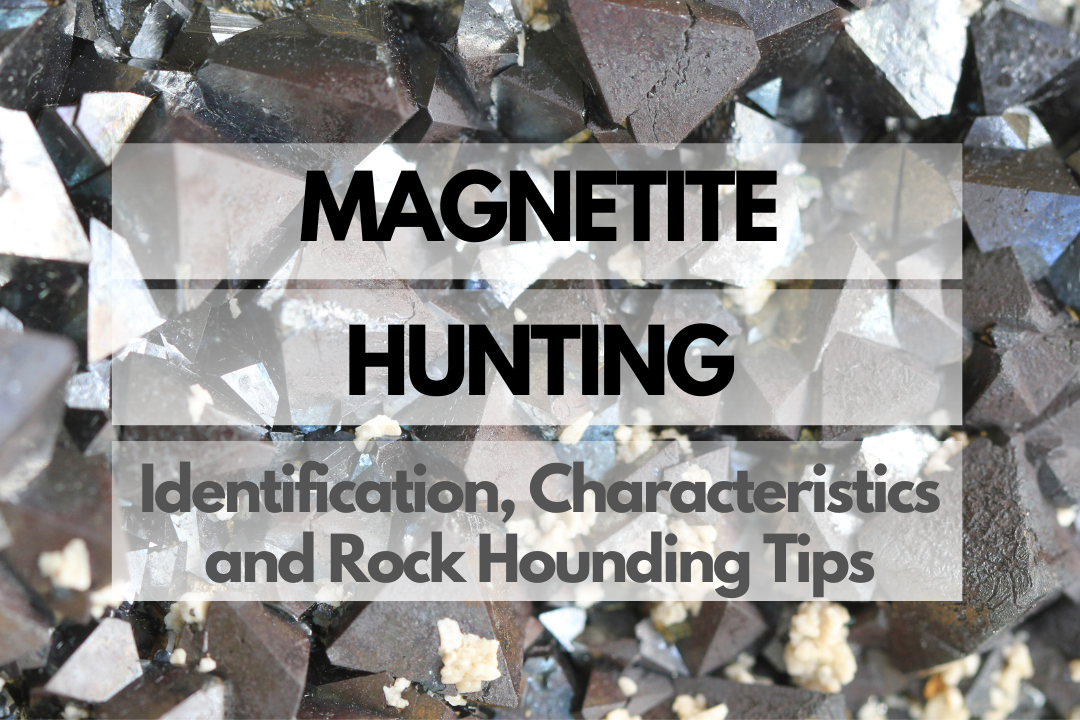Imagine discovering a rock with magnetic properties, drawing you in with its pull! Welcome to the world of magnetite hunting, where the adventure lies in uncovering this unique and fascinating mineral. In this article, we’ll explore the history, identification, characteristics, and uses of magnetite, as well as tips for rock hounding enthusiasts who want to add this intriguing rock to their collection.
History & Origin of Magnetite
Magnetite is an iron oxide mineral that has been known for its magnetic properties since ancient times. It was first discovered in the region of Magnesia in modern-day Turkey, which is where it gets its name. The mineral has held significant cultural importance throughout history, with various civilizations using it for navigation, protection, and even health. For example, the ancient Greeks believed that magnetite could heal a variety of ailments, while the Chinese made use of its magnetic properties to create early compasses.
Magnetite Identification & Physical Properties
Identifying magnetite involves understanding its unique physical properties. The following table provides an overview of these characteristics:
| Property | Description |
|---|---|
| Chemical Formula | Fe3O4 |
| Crystal System | Isometric |
| Cleavage | None |
| Fracture | Conchoidal to Uneven |
| Luster | Metallic to Submetallic |
| Transparency | Opaque |
| Streak | Black |
Magnetite Colors
Magnetite is typically black or dark brown in color, with a metallic to submetallic luster that gives it a shiny appearance.
Magnetite Hardness
On the Mohs scale of mineral hardness, magnetite ranks between 5.5 and 6.5, making it a relatively hard mineral that is resistant to scratching.
Magnetite Types
Lodestone
Lodestone is a naturally magnetized variety of magnetite, which is known for its strong magnetic properties. This type of magnetite was historically used as an early form of compass by ancient mariners.
Titanomagnetite
Titanomagnetite is a variety of magnetite that contains significant amounts of titanium. This type of magnetite typically forms in igneous rocks and has a slightly different color and appearance compared to pure magnetite.
Magnetite Uses
Magnetite has a variety of uses, both practical and industrial. Some of these include:
- Iron ore: Magnetite is an important source of iron for steel production.
- Heavy media separation: Due to its high density, magnetite is used in coal processing and other industrial applications to separate materials by weight.
- Water purification: Magnetite’s magnetic properties make it useful for removing impurities in water treatment processes.
- Electronics: Magnetite is used in the production of certain electronic components and devices due to its magnetic properties.
- Health and wellness: Some believe that magnetite has healing properties and use it in alternative therapies, such as magnetic therapy and crystal healing.
How Much Is Magnetite Worth?
The value of magnetite varies depending on factors such as size, quality, and demand. In general, magnetite specimens can range from a few dollars to several hundred dollars per pound, with higher quality specimens commanding a premium price. It’s essential to research the current market value of magnetite and consult with experts to determine the worth of a specific specimen.
Magnetite Rock Hounding Tips
Ready to embark on a thrilling magnetite hunting adventure? Here are some tips and tricks to help you have a successful and enjoyable experience:
Essential Tools and Equipment
Before you head out, make sure you have the right tools and equipment for magnetite hunting. Some essentials include:
- Rock hammer: A sturdy rock hammer will help you break apart rocks and collect specimens.
- Magnet: A strong magnet is a crucial tool for identifying magnetite and distinguishing it from other similar-looking rocks.
- Hand lens or magnifying glass: A hand lens will help you examine the fine details and characteristics of your magnetite specimens.
- Geological map: A detailed geological map can guide you to areas where magnetite is more likely to be found.
- Field notebook and pen: Recording your observations and discoveries will help you learn and grow as a rock hound.
- Backpack or collecting bag: A durable bag will help you carry your tools and collected specimens.
Safety Tips
Rock hounding can be a fun and rewarding adventure, but it’s essential to prioritize safety. Keep these safety tips in mind:
- Wear appropriate clothing, including sturdy shoes, long pants, and gloves to protect yourself from sharp rocks and potential hazards.
- Bring plenty of water and snacks to stay hydrated and energized during your hunt.
- Always let someone know where you’re going and when you plan to return.
- Be cautious when using a rock hammer, and always wear safety goggles to protect your eyes from flying debris.
- Be aware of your surroundings, and avoid hunting in areas where there may be potential hazards such as unstable ground or rock falls.
Magnetite Hunting: Where to Find Magnetite
Magnetite can be found in various locations around the world, often in igneous and metamorphic rocks. The following table provides an overview of some specific sites and areas where you can find magnetite:
| Site/Area | Location |
|---|---|
| Kiruna | Kiruna, Sweden |
| Kudremukh | Karnataka, India |
| Iron Springs District | Utah, USA |
| Geraldton | Western Australia, Australia |
| El Laco | Antofagasta, Chile |
Caring For Your Magnetite
Once you have collected your magnetite specimens, it’s essential to care for them properly. You can clean your specimens using a toothbrush and a mild soap solution, then rinse them thoroughly with water to remove any remaining soap residue. To display your magnetite, you can use a mineral display case or create an attractive arrangement on a shelf or tabletop. Avoid exposing your magnetite specimens to direct sunlight for extended periods, as this can cause fading and damage over time.
Additional Resources
Expand your knowledge and connect with fellow rock hounds by exploring these helpful resources:
- United States Geological Survey (USGS): https://www.usgs.gov/
- Mindat.org: An online mineralogy database and community: https://www.mindat.org/
- Rock & Gem Magazine: A publication dedicated to rock hounding and lapidary arts: https://www.rockngem.com/
- Rockhound Lounge: An online forum for rock hounds: http://www.rockhoundlounge.com/
- Books: “Rockhounding: A Guide to Minerals, Gems, and Fossils” by Richard Busch or “The Rockhound’s Handbook” by James R. Mitchell
Here are some frequently asked questions about magnetite that you might find helpful:
What are the benefits of Magnetite?
Magnetite is an important iron ore and has various industrial uses, including in the production of steel and as a pigment in paints and ceramics. Additionally, magnetite’s natural magnetic properties have made it useful in the development of magnetic recording media, such as magnetic tapes and hard drives.
Do Magnetite have any healing properties?
While some people believe that magnetite has healing properties, such as relieving stress, improving blood circulation, and increasing energy levels, there is no scientific evidence to support these claims. It’s essential to consult a medical professional for any health-related concerns.
Do Magnetite have any spiritual meaning?
In some spiritual and metaphysical traditions, magnetite is considered to have grounding and balancing properties, helping to align the body’s energy centers and promoting emotional stability. However, these beliefs are subjective and may not hold the same meaning for everyone.
Do I need a permit to go Magnetite hunting?
In some areas, you may need a permit or permission to collect rocks, including magnetite, on public lands. It’s essential to research the regulations in the area where you plan to hunt and follow any applicable rules. The U.S. Bureau of Land Management (BLM) provides information on collecting rocks on public lands: https://www.blm.gov/programs/recreation/rocks-and-minerals
Closing Thoughts
Armed with these tips and resources, you’re ready to embark on your exciting magnetite hunting adventure. Remember to prioritize safety, respect the environment, and enjoy the thrill of discovering these fascinating magnetic rocks in the great outdoors. Happy rock hounding!

